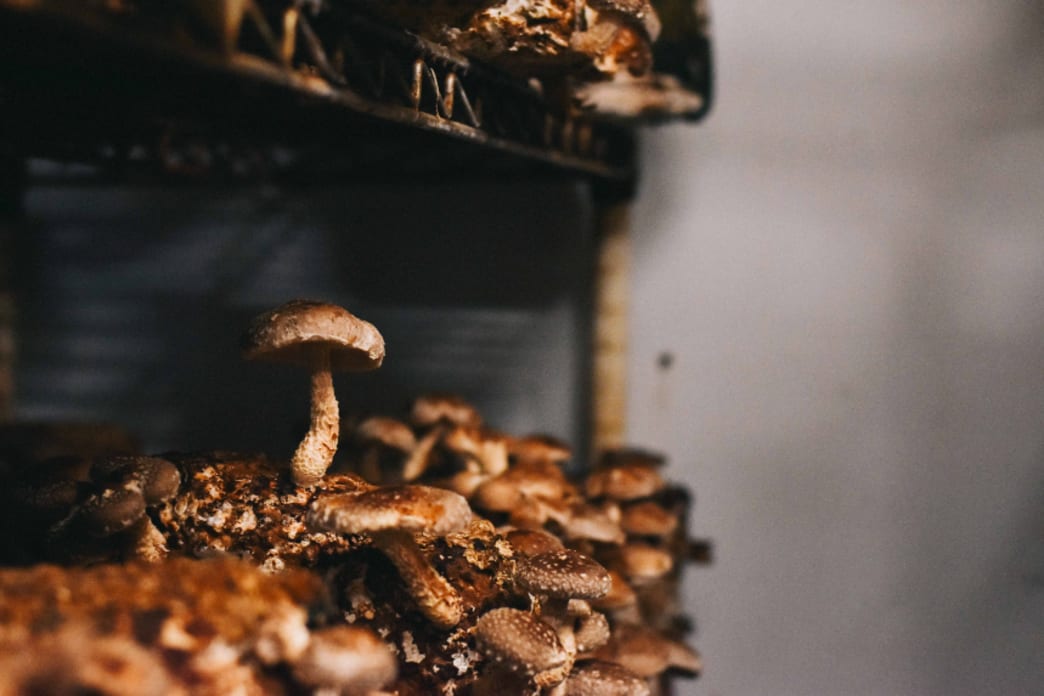Growing medicinal mushrooms like shiitake mushroom is a fun, healthy way to further your relationship with fungi
There is a quote oftentimes ascribed to Hippocrates that goes: “Let thy food be thy medicine and medicine be thy food.”
Food as medicine is a concept that has been around for a long time. Of course, many types of food have beneficial nutrients, vitamins, minerals, and other healthful constituents. Mushrooms are no exception. We’re here to help people grow more mushrooms at home or on small-scale mushroom farms. This includes gourmet edible and medicinal mushrooms. Below we are looking at some methods for growing medicinal mushrooms that are also tasty additions to an array of meals.
Growing medicinal mushrooms: Shiitake
Shiitakes are the gateway mushroom into the field of specialty mushrooms. Shiitake is a Japanese word: “take” meaning mushroom and “shii” being a kind of evergreen tree that grows in Japan and Korea.
Shiitakes have a strong umami flavor and stand out in culinary dishes. The stems of shiitakes are typically discarded or made into stock and the caps are cooked. Shiitakes have a high protein content around 18% (dry weight), and a complete profile of amino acids.
In a scientific study regular consumption of 10 grams of shiitake “resulted in improved immunity, as seen by improved cell proliferation and activation.” Shiitakes are great in stir fries, miso soup, or roasted on their own!
Selecting and preparing logs for growing shiitake mushrooms
The first step to mushroom cultivation on logs is cutting and selecting logs to grow on. The best results have been achieved when logs are sourced in the fall from trees whose leaves have changed by about 30%. If logs have been sitting for two months or more than it’s good to rehydrate the logs before inoculating. You can rehydrate the logs by soaking them in water for 3-6 hours. It’s best to select logs with the bark intact, while avoiding logs with large strips of bark removed.
Dense hardwoods like oak, sugar maple, and beech are great species to use for growing shiitakes. Logs with a diameter of 3-8 inches that are about 4 feet long are ideal. Smaller logs colonize and fruit faster than larger logs, and smaller logs are also easier to move when necessary. The last factor to think about during log selection is the ratio of sapwood to heartwood. Logs with a higher ratio of sapwood will offer more food for the shiitake to digest and offer a larger yield.
Growing medicinal mushrooms: Preparing the logs by drilling holes
How to create the holes will depend on the type of spawn you are using and the tools you have for the job. For sawdust spawn, use a 12 mm drill bit, or whatever size bit that will match the inoculation tool. For plug spawn, use a 5/16 drill bit. You will want to drill 1” deep holes.
Start drilling the holes about 1” away from the end of the log. Drill again 6” down the log and continue to space holes every 6” down the length of the log. Start the next row of holes 2” away from the previous row, spinning the log around. The holes should be offset, so now you are drilling 2” below the original line and in the middle of the previous holes. Drill holes all the way around the circumference of the log so you end up with a diamond pattern.
Growing medicinal mushrooms: Inoculating the holes with spawn
You are now ready to add spawn to the log. If you have sawdust spawn, break it up with your hands before opening. Work the spawn into little pieces, making it easier to fill an inoculation tool if you are using one. Fill the palm inoculator or a similar tool completely with spawn. You can do so by stabbing the spawn two or three times and then inoculating each hole one at a time. There are several new tools in the United States, like the Okuda inoculator, which allow for the inoculation of multiple holes at once after filling them up with spawn. These also seal the hole with a styrofoam cap instead of needing to wax.
If you are using plug spawn, simply place the plug on the hole and then tap it in with a hammer. The plug should be flush or slightly sunken below the surface of the log, allowing for the wax to poll over and seal accordingly. This sunken seal will remain protected and last longer than wax that is protruding outside the layer of bark.
Growing medicinal mushrooms: Waxing over the inoculated holes
You can do this by melting wax and pour it over the holes. Cheese wax or beeswax are viable options for wax to use because they hold form as temperatures fluctuate and they tend not to crack. If the wax cracks , then the spawn can dry out and die. The wax prevents the spawn from drying out and keeps other fungi out of the log. Depending on the scale of operation, wax can be applied with a cotton ball type material on the end of a stick, a paint brush, or a specialized tool for applying wax.
If you want to learn even more about shiitake cultivation, then you should check out our free guidebook. It has all of this information and so much more! Also, don’t forget that you can buy sawdust spawn and plug spawn from us if you want to inoculate your own logs at home.

